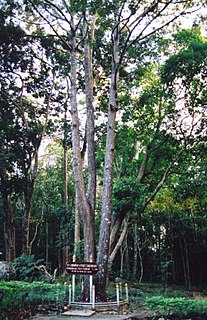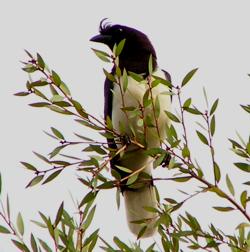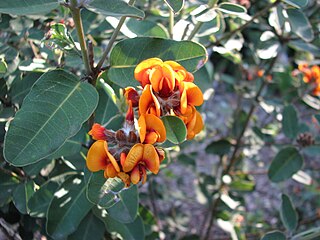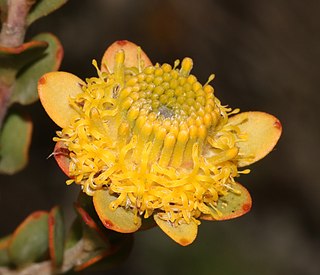
The yellow-headed caracara is a bird of prey in the family Falconidae. It is found in tropical and subtropical South America and the southern portion of Central America. Unlike the falcons in the same family, the caracara is not a fast-flying aerial hunter, but is rather sluggish and often obtains food by scavenging.

Shorea is a genus of about 196 species of mainly rainforest trees in the family Dipterocarpaceae. The genus is named after Sir John Shore, the governor-general of the British East India Company, 1793–1798. The timber of trees of the genus is sold under the common names lauan, luan, lawaan, meranti, seraya, balau, bangkirai, and Philippine mahogany.

Caryocar is a genus of flowering plants, in the South American family Caryocaraceae described as a genus by Linnaeus in 1771. It is native primarily to South America with a few species extending into Central America and the West Indies.

Güeppi-Sekime National Park is a protected area located in the Peruvian region of Loreto, on the border with Ecuador. The park encompasses 203,628.51 hectares (2,036 km2) of forests in a landscape that features hills and seasonally flooded lowlands.

Dekeyser's nectar bat is a bat species from South America. It is found in Brazil and Bolivia.

The curl-crested jay is a jay from South America.

Caryocar nuciferum, the butter-nut of Guiana, is also known as pekea-nut, or – like all other species of Caryocar with edible nuts – "souari-nut" or "sawarri-nut". It is a fruit tree native to northern Brazil, Colombia, Costa Rica, Guyana, Panama, and Venezuela.
Beauprea congesta is a species of plant in the family Proteaceae. It is endemic to New Caledonia.
Beauprea crassifolia is a species of plant in the family Proteaceae. It is endemic to New Caledonia.
Caryocar amygdaliforme is a species of tree in the Caryocaraceae family. It is native to South America.

Caryocar costaricense is a species of plant in the Caryocaraceae family. It is found in Colombia, Costa Rica, Panama, and Venezuela. It is threatened by habitat loss.

Pittosporum coriaceum is a species of plant in the Pittosporaceae family. It is endemic to Macaronesia, and due to extinction in the Canary Islands, it is now restricted to the Portuguese Madeira Islands.

Caryocar brasiliense, known as pequi or "souari nut", like its congeners, is an edible fruit popular in some areas of Brazil, especially in Centerwestern Brazil.

Ophioglossum lusitanicum, the least adder's-tongue, is a small fern of the family Ophioglossaceae. It is a pan-tropically species categorised as least concern by the IUCN (2001).

Caryocar glabrum is a species of tree in the family Caryocaraceae. It is native to South America.

Gastrolobium coriaceum is a shrub species in the family Fabaceae. It is endemic to the south west of Western Australia.

Araeosoma coriaceum is a species of sea urchin of the family Echinothuriidae. Their armour is covered with spines. It is placed in the genus Araeosoma and lives in the sea. Araeosoma coriaceum was first scientifically described in 1879 by Alexander Emanuel Agassiz, an American scientist.

Placospermum is a genus of a single species of large trees, constituting part of the plant family Proteaceae. The species Placospermum coriaceum is endemic to the rainforests of the wet tropics region of northeastern Queensland, Australia. Common names include rose silky oak and plate-seeded oak.
Dialyceras coriaceum is a tree in the family Sphaerosepalaceae. It is endemic to Madagascar.

Leucadendron coriaceum, the rosette conebush , is a flower-bearing shrub that belongs to the genus Leucadendron and forms part of the fynbos. The plant is native to the Western Cape and occurs from Napier to Riversdale.














